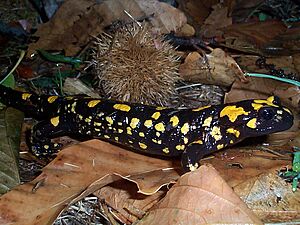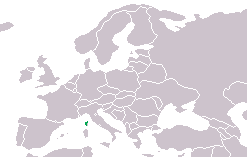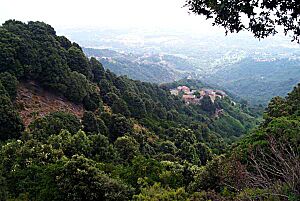Corsican fire salamander facts for kids
Quick facts for kids Corsican fire salamander |
|
|---|---|
 |
|
| Conservation status | |
| Scientific classification | |
| Genus: |
Salamandra
|
| Species: |
corsica
|
| Synonyms | |
|
|
The Corsican fire salamander (Salamandra corsica) is a special type of salamander that lives only on the island of Corsica. This means it's an endemic species, found nowhere else in the world! For a long time, people thought it was just a subspecies of the more common fire salamander, but now we know it's a unique species.
Contents
What Does It Look Like?
Corsican fire salamanders are shiny black with bright yellow spots or patches on their backs. They can grow quite large, from about 12 centimeters (5 inches) up to 30 centimeters (12 inches) long. Usually, males are a bit smaller than females.
Their heads are wider than they are long and have a rounded shape. These salamanders have bright yellow glands behind their eyes called paratoid glands. They also have two rows of poison glands running down their sides and two more rows along their tails. Their snouts, toes, and the tip of their tails are all blunt and rounded.
Male salamanders have a noticeable cloaca, which is a single opening for waste and reproduction. The Corsican fire salamander has smooth, shiny skin. You can also see clear grooves along their sides, which are called costal grooves.
Where Do They Live?
The Corsican fire salamander mostly lives in the deciduous mountain forests on the island of Corsica. Deciduous trees are those that lose their leaves in the fall. While they are usually found in forests, some have been seen near sea level on the west coast.
They prefer forests with trees like sessile oak, downy oak, and even sweet chestnut gardens near towns. They also live in forests with maritime pine and the Corsican black pine.
However, very thick ferns or evergreen forests with holly oak are not ideal for them. This is because these areas don't get as much rain. Beech forests are also home to these salamanders, especially in the Castagniccia region and the south of the island.
The middle parts of the Corsican mountains are perfect for them. These areas have steady humidity and mild temperatures. Streams flowing down from the mountain tops provide constant water, which is important for the salamander larvae to grow during the warm summer. The rocky areas around these streams also offer great hiding spots for adult salamanders during the day or dry periods.
Amazing Ways to Have Babies
A German scientist named Robert Mertens once found a pregnant Corsican fire salamander in the Restonica Valley. What was amazing was that she gave birth to four babies that already looked like mini-adults! They didn't have gills and already had the black and yellow colors.
At the same time, he also found normal salamander larvae in the water. These larvae had their three feathery gills on each side of their heads and were camouflaged to blend in with the pond's bottom.
This shows that Corsican fire salamanders can have babies in different ways. Giving birth to fully developed young without gills is called viviparity. This ability is also seen in some other salamanders, like a subspecies of the fire salamander from Spain and the alpine salamander. Scientists think this special way of having babies helps them survive in drier places where there might not always be ponds or streams for their larvae to grow.
What Dangers Do They Face?
The Corsican fire salamander faces several threats that put its future at risk. One big problem is habitat loss. This happens when their forest homes are cut down for logging, or when new roads are built. Traffic on these roads can also be dangerous for them.
Other dangers include water pollution, wildfires, and changes to their forest homes from grazing animals. A major threat comes from introducing new fish species, like rainbow trout, into the streams where salamander larvae grow. These invasive fish eat the young salamanders, which greatly reduces how many new salamanders survive.
Luckily, native fish, like the Mediterranean trout, don't seem to harm the salamanders.




